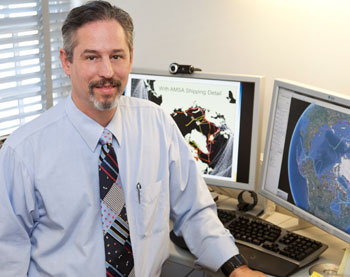More ships, more pollution as Arctic warms

RESEARCH | As the ice-capped Arctic Ocean warms, ship traffic will increase at the top of the world. And if the sea ice continues to decline, a new route connecting international trading partners may emerge—but not without significant repercussions to climate.
Those are the findings of a U.S. and Canadian research team that includes a UD scientist.
Growing Arctic ship traffic will bring with it air pollution that has the potential to accelerate climate change in the world’s northern reaches, according to the researchers. And, they say, it’s more than a greenhouse gas problem, as engine exhaust particles could increase warming by some 17-78 percent.
James J. Corbett, professor of marine science and policy at UD, is a lead author of the first geospatial approach to evaluating the potential impacts of shipping on Arctic climate. The study, “Arctic Shipping Emissions Inventories and Future Scenarios,” was published recently in Atmospheric Chemistry and Physics.
“One of the most potent ‘short-lived climate forcers’ in diesel emissions is black carbon, or soot,” Corbett says. “Ships operating in or near the Arctic use advanced diesel engines that release black carbon into one of the most sensitive regions for climate change.”
Produced by ships from the incomplete burning of marine fuel, these tiny particles of carbon act like heaters because they absorb sunlight, both directly from the sun and also as reflected from the surface of snow and ice. Other particles released by ship engines also rank high among important short-lived climate forcers, and this study estimates their combined global warming impact potential.
To better understand the potential impact of black carbon and other ship pollutants on climate, including carbon dioxide, methane and ozone, the research team produced high-resolution (5-kilometer-by-5-kilometer) scenarios that account for growth in shipping in the region through 2050, and also outline potential new Arctic shipping routes.
Among the research team’s most significant findings:
• Global warming potential in 2030 in the high-growth scenario suggests that short-lived forcing of about 4.5 gigagrams of black carbon from Arctic shipping may increase the global warming potential due to ships’ carbon dioxide emissions by some 17-78 percent.
• Ship traffic diverting from current routes to new routes through the Arctic is projected to reach 2 percent of global traffic by 2030 and 5 percent in 2050. In comparison, shipping volumes through the Suez and Panama canals currently account for about 4 percent and 8 percent of global trade volume, respectively.
• A Northwest Passage and Northeast Passage through the Arctic Ocean would provide businesses with a distance savings of about 25 percent and 50 percent, respectively, with coincident time and fuel savings. However, the team says tradeoffs from the short-lived climate forcing impacts must be studied.
• To calculate possible benefits of policy action, the study provides scenarios that take into account the incorporation of emissions control technologies such as seawater scrubbers that absorb sulfur dioxide emissions. Their scenario shows that with controls, the amount of Arctic black carbon from shipping can be reduced in the near term and held nearly constant through 2050.
“Our hope is that this study will enable better communication of emerging science with policy makers and aid the eight Arctic Council nations with climate policy,” Corbett says.
Article by Tracey Bryant





